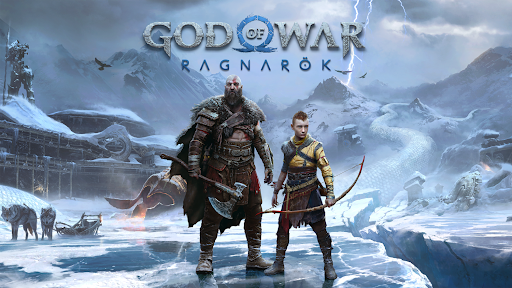God Of War Ragnarök: Game Review

God Of War is a series of video games about the Greek god slayer, Kratos. There have been seven games so far in the God Of War’s first era, reiterating the story of the Ghost of Sparta as he seeks revenge against the Greek Gods.
Beginning with PS2, this Greek God’s era of Krato’s story began prior to the 2018 soft reboot, God Of War. This pretty much means that you don’t have to play the previous versions of the series to have fun and understand the story of God Of War Ragnarök.
The apocalyptic Ragnarok circles around his son Atreus like one of Odin’s ravens. Fimbulwinter—a time of unrest that presages Ragnarok—has very much come, and, during the intervening years, Atreus grows stronger, learning about his giant name “Loki” and trying to convince his father to trust him.
There are some moving callbacks to the hunting scene from the 2018 God Of War as Kratos proudly watches Atreus prove that he’s no longer a child. But it’s definitely not a slow introduction to the game. Ragnarok wastes no time in stepping into the action, and, after a breakneck opening battle, the first step of this new journey is to leave the frozen realm of Midgard and find a missing Norse god in the broader and more varied universe.
Well, let’s know more about the sequel in this non-spoiler review for God Of War: Ragnarok.
Relations between Characters
If you ever played 2018’s God Of War, then you know that the story of Kratos and Atreus is one of the most emotional and surprising stories in a video game to date. The father-and-son duo’s emotional dynamics are incredibly familiar and tough to watch.
However, all their development through the game was very significant, not only for them but also for those playing along. The ending summed up everything they went through, bringing the cathartic moment together. The game was satisfying in ways that you don’t always expect or receive from video games.
In the very first game, we get to understand that Kratos is strict with Atreus because he wants him to be stronger, more self-sufficient, and a courageous warrior. As they begin their journey to scatter the ashes of Atreus’ mother, the dangers and unexpected events they encounter in order to create a stronger bond between them.
In God Of War: Ragnarok, the plotline begins several years after the end of the previous one, with Atres a teenager and Kratos still being the same old grumpy god. Their relationship advances past the difficult relationship we got to see at the beginning of 2018’s God Of War. Instead of just a typical father-and-son relationship, they are a closer family than ever before.
The gameplay, easter eggs, familiar characters, etc. are not relevant in this case, but of course, they are still part of the whole process of going through this game.
Kratos and Atreus are not the only characters in the game whose relationships are a major plot point. There is also Thor (who we saw at the end of God Of War), Odin, Freya, Tyr, Mimir, Heimdall, Sindri, Brok, Angrboda, and Durlin.
Character Traits
Each character gets their own moment to shine throughout. These characters, too, have unique characteristics that make them stand out throughout the game’s plot. Sunny Suljic fires back regularly with the sharp, teenage tongue of a brasher.
Alastair Duncan’s severed head accessory, Mimir, provides levity and exposition in abundance. Týr is charmingly plucky as the Norse God Of War. The foul-mouthed Brok and skittish Sindri continue to bring their unique brand of dwarven charm while granting you those all-important upgrades.
As they play a much more central role in the story this time around, they frequently provide pockets of humour as well as a lot of genuinely helpful information along the way.
Gameplay & Environment
A huge portion of the gameplay from God Of War is present in God Of War: Ragnarok in 1:1 form. Several elements are still the same as in the past, with respect to the environment; because of the coming apocalypse, everything in Midgard is covered in snow. This makes some places unrecognisable and allows the player to revisit familiar places in a new way without feeling like it’s the same game.
New worlds bring dangerous new threats with them. Familiar foes such as draugr and elves have made their way across, but this time they’re joined by Grims, grim scuttling toad people, and the Einherjar; Aesir warriors who harness the power of the Bifrost, which makes a section of your health bar glow before removing that chunk on the next hit. There’s an engaging but never unfair difficulty curve throughout the gameplay as you’re met with progressively greater threats.
Side missions are a spectacle in their own right. Standout favors involve helping giant creatures in distress. Adventures are full of personal revelations as you traverse through the lush jungles of Vanaheim. They are a great source of character development as you learn more about your friends and companions by helping them right past wrongs. Some side quests do just present a pure gameplay challenge over extra stories, however, such as hunting down powerful legendary enemies dotted across the realms of Yggdrasil’s roots.
The environment in the game is much more vivid, giving you a sense that you are inside this world, not as a player, but as the main character. The wildlife elements are surprisingly close to real animal behaviour, in our reality, something that makes you feel that they have been imported straight from “our world.”
Travelling is smoother in comparison to the previous game. There are add-ons such as Blades of Chaos and Leviathan’s Axe that can now be used in many creative ways. You can now reach higher ledges, jump between walls, and smash cracked earth, which was not something that you could do as a player in God Of War 2018. As before, Axe can freeze liquid things, and destroy distant objects, with the addition of bouncing off special platforms.
Audio & Graphics
Composer Bear McCreary also returns in God Of War Ragnarök, whose score goes hammer and tongs from the first moment to the last. There’s some truly beautiful music to be heard along the journey, as well as explosions of raw orchestral power during intense fight scenes.
The artistry is astonishing, bursting through every seam and frame, even when running in the high frame rate-favoring Performance mode. It provides excellent costumes and world design for the show.
Ragnarok is incredibly well polished, with little details right from the etchings on a dagger to the clunk of a cupboard door closing showing love. It’s expertly animated, with sputtering grimaces when launched towards the lens during the heat of battle, and hair flowing realistically on Kratos’ less-follically challenged enemies.
A Song of Ice and Fire
God Of War’s combat has always been the main attraction that has drawn players to the game and to the story. God Of Ragnarok follows suit. It may seem familiar at first, and indeed, some things remain the same, but it isn’t afraid to play with expectations and throw a curveball now and then.
Kratos’ blades whip around in every direction, delivering a clanking, fiery pain to any face they meet. Heavy cleaves of his axe crunch into enemies, making them fold like bloodied origami. You can bet that you feel the heavy heat of the DualSense controller’s haptics in what remains one of the most satisfying button presses ever assigned to a controller.
It’s all unapologetically fast, and undeniably glorious, bringing in the aforementioned frantic action in which the series was originally rooted. Some segments simply drag on for too long. There are instances where characters have too much exposition and the pacing slows down to a crawl. Thankfully, the combat is more than fun enough to reward your patience.

